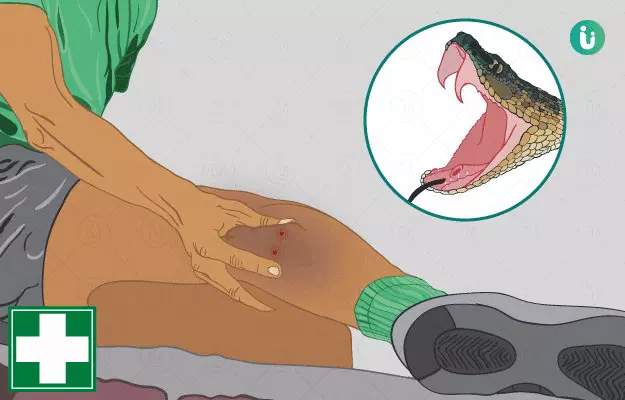Snakes are common in many parts of India and often make their way into homes in urban areas from surrounding forested areas as well. Snakes bite by creating deep puncture wounds with their narrow front teeth called fangs. After creating a puncture wound, snakes commonly release their venom, or poison, which penetrates deep into the soft tissues of the body. It is important to not only give the appropriate first aid correctly and quickly but to also be able to identify the snake that made the bite. This is because different types of snakes release different types of poisons which may need specific treatment. In India, over a million people die each year from snake bites.
- Recognising a snake bite
- Recognising snakes
- What to do in case of a snake bite
- Medical treatment for snake bites
- Complications of snake bites
Recognising a snake bite
Depending on the type of venom the snake that made the bite possesses, signs and symptoms may vary. Some features that can appear with a snake bite include:
- Two fang marks or wounds that look punctured
- Bleeding from the wound
- Localised swelling, warmth, burning and redness around the bite
- Severe pain around the bite
- Change in skin colour
- Diarrhea and fever
- Stomach ache and headache
- Difficulty in breathing
- Nausea and vomiting
- Shock and convulsions
- Allergic reactions
- Vision going blurry
- Increased sweating and salivation
- Numbness and tingling in the limbs and face
- Drooping of eyelids
- Paralysis
- Rapid pulse
- Tiredness and muscle weakness
- Excess thirst
- Low Blood pressure
Recognising snakes
Although various poisonous snakes exist around the world, in India, only 4 poisonous snakes that require their own special antivenom treatment are common. If it is not possible to identify the snake at the time of the bite, a photograph of it should be taken to the hospital as it can help identify it. If the snake has been killed, it should be taken with the patient to the healthcare facility.
Common distinguishing features of the ‘Big Four’ poisonous Indian snakes are described here:
- Common krait (Bungarus caeruleus): The head is flat and the neck hardly evident. The body is cylindrical, tapering towards the tail and is black or bluish-black, with about 40 thin, white crossbars.
- Russell’s viper (Daboia russelii): The head is flattened, triangular and distinct from the neck. The nostrils are large and raised and the eyes are prominent. The body is cylindrical and a yellow to brown colour with three columns of brown spots with black outlines running along with it.
- Indian saw-scaled viper (Echis carinatus): The snakes are relatively short in length and create a “sizzling” sound as they slither. Their body is grey, brown, red or olive green with white spots. Their eyes are large and the underbelly is white.
- Indian cobra (Naja naja): The snake’s body is thin and cylindrical but a “leaf-shaped” hood is present at its head end, which is called the hood. The body can be black, brown or cream coloured but a wide black band on the underside of the neck and black circular spots or “false eyes” on the upper surface of the hood are always present.
What to do in case of a snake bite
First aid steps to take while assisting a snake bite patient can be remembered as CARRY NO R.I.G.H.T.
- CARRY the patient out of striking distance from the snake. If the patient needs to be moved, do not allow the patient to walk, especially in case of a snake bite on the leg.
- NOne of the following measures should be taken as they could complicate matters more:
- No tourniquet
- No electrotherapy
- No cutting of the snake bite wound
- No attempt to suck out the venom
- No application of a tight bandage
- No application of ice packs
- No caffeinated drinks or alcohol should be given to the patient
- Reassure the patient: Try calming the patient down and ask them to remain still. Agitated movements can spread the venom in the body.
- Immobilise the patient: To prevent the spread of snake venom, the patient should be asked to remain still. Make the patient lie down with the snake bite wound below heart level.
- Get to the nearest Hospital: Snake bites need to be assessed and when needed antivenom needs to be given.
- Tell the doctor about the symptoms and give a description of the snake if possible.
Medical treatment for snake bites
After the patient reaches a healthcare facility, the doctors will assess the snake bite wound. A description or photograph of the snake can help manage treatment. In India, a polyvalent anti-snake-venom (ASV) that contains antivenoms of the Big Four snakes is available. A dose of about 60 to 100 mL is administered for both adults and children as an hour-long intravenous infusion. The dose may have to be repeated if bleeding persists for more than six hours after the snake bite or neurological symptoms arise. Sometimes, an allergic reaction can arise due to the ASV, which is managed with anti-allergy medication. ICU care may be needed if the patient is critically ill.
(Read more: Drug allergy)
Complications of snake bites
Some serious complications that can occur following a snake bite are:
- Bleeding
- Kidney failure
- Severe allergic reaction
- Tissue death around the bite
- Breathing problems
- Amputation
- Death
(Read more: First aid for difficulty breathing)
Find Emergency medicine specialist in cities
- Emergency medicine specialist in Gurgaon
- Emergency medicine specialist in Delhi
- Emergency medicine specialist in Kurung Kumey
- Emergency medicine specialist in Una
- Emergency medicine specialist in South 24 Parganas
- Emergency medicine specialist in Jammu
- Emergency medicine specialist in Jaipur
- Emergency medicine specialist in Washim
- Emergency medicine specialist in Dhar
- Emergency medicine specialist in Thoubal









